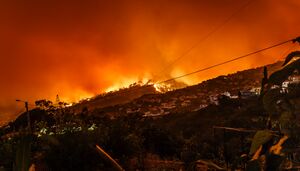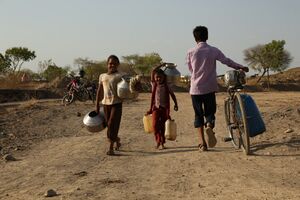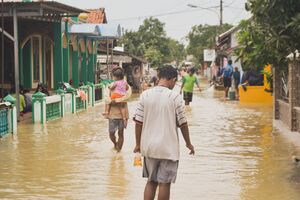Climate Change
Original Editor - Lucinda hampton
Top Contributors - Lucinda hampton and Angeliki Chorti
Introduction[edit | edit source]
Climate change describes a change in the average conditions, eg temperature and rainfall, in a region over a long period of time. Earth’s climate has constantly been changing, even long before humans came into the picture. However, scientists have observed unusual changes recently. For example, Earth’s average temperature has been increasing much more quickly than they would expect over the past 150 years[1].
Impacts on Health[edit | edit source]
Over the last 50 years, human activities have released sufficient quantities of carbon dioxide and other greenhouse gases to affect the global climate.
- Climate and weather variables pose threats to food and water security, and cause outbreaks of waterborne and vectorborne diseases.
- The increased pressure on scarce resources triggers climate-related migration and conflicts[2].
- Climate change affects the social and environmental determinants of health eg clean air, safe drinking water, sufficient food and secure shelter[3].
- Areas with weak health infrastructure, mainly developing countries, will be the least able to cope without assistance to prepare and respond[3].
- Under business-as-usual scenarios, it is estimated that between 2030 to 2050, climate change will cause an additional 250 000 deaths annually.[2]
Extreme Heat[edit | edit source]
Health consequences
- Extreme high air temperatures contribute directly to deaths from cardiovascular and respiratory disease, particularly among elderly people. eg in the heat wave of summer 2003 in Europe more than 70 000 excess deaths were recorded.
- High temperatures raise the levels of ozone and other pollutants in the air exacerbating cardiovascular and respiratory disease.
- Pollen and other aeroallergen levels rise in extreme heat, potentially triggering eg asthma which affects around 300 million people.[3]
Natural Disasters and Rainfall Changes[edit | edit source]
Globally, the number of reported weather-related natural disasters has more than tripled since the 1960s. Every year, these disasters result in over 60 000 deaths, mainly in developing countries.
- Rising sea levels and increasingly extreme weather events will destroy homes, medical facilities and other essential services. More than half of the world's population lives within 60 km of the sea. People may be forced to move, which in turn heightens the risk of a range of health effects, from mental disorders to communicable diseases.
- Increasingly variable rainfall patterns are likely to affect the supply of fresh water. A lack of safe water can compromise hygiene and increase the risk of diarrhoeal disease, which kills over 500 000 children aged under 5 years, every year. Decreased rainfall can also lead to famine and drought. By the late 21st century, climate change is likely to increase the frequency and intensity of drought at regional and global scale.
- Rising temperatures and variable precipitation are likely to decrease the production of staple foods in many of the poorest regions, increasing the prevalence of malnutrition and undernutrition (currently cause 3.1 million deaths every year).
- Floods are also predicted to rise, these may: contaminate freshwater supplies; heighten the risk of water-borne diseases, and create breeding grounds for disease-carrying insects such as mosquitoes; cause drownings and physical injuries; damage homes and disrupt the supply of medical and health services.
Infection Patterns[edit | edit source]
- Climatic conditions strongly affect water-borne diseases and diseases transmitted through insects, snails or other cold-blooded animals.
- Changes in climate are likely to lengthen the transmission seasons of important vector-borne diseases and to alter their geographic range.
- The Aedes mosquito vector of dengue is also highly sensitive to climate conditions, and studies suggest that climate change is likely to continue to increase exposure to dengue.[3]
Physiotherapy implications[edit | edit source]
Reduced physical activity (PA): At present, cold, extreme heat and precipitation are all associated with reduced PA. Over time, global warming is poised to play a growing influence on PA levels.
- An increase in physical inactivity is projected in locations that already experience high temperatures.
- In the high temperature regions, further decreases in physical activity will have devastating implications for population health and should be accounted for in factoring the costs of climate change and the justification for mitigation efforts.
- Rising temperatures may increase PA in locations affected by cold climate.[4].
Who is most affected?[edit | edit source]
Most systematic reviews of the health impacts of climate change suggest an association between climate change and the deterioration of health in multiple ways, generally in the direction that climate change is associated with adverse human health outcomes[5].
- Developing countries are particularly affected by the impacts of climate change. They are hit hardest because they are more vulnerable to the damaging effects of a hazard but have lower coping capacity. Eight out of the ten countries most affected by the quantified impacts of extreme weather events in 2019 belong to the low- to lower-middle income category. Half of them are Least Developed Countries[6].
- Areas with weak health infrastructure (mostly in developing countries) will be the least able to cope without assistance to prepare and respond (as we have seen in the COVID 19 pandemic).[3]
- Reducing emissions of greenhouse gases through better transport, food and energy-use choices can result in improved health, particularly through reduced air pollution.Health effects of climate change are unlikely to be distributed equally or randomly through populations. It will be important to mitigate the changing climate’s potential to exacerbate health inequities[5].
Solutions[edit | edit source]
Climate change is already an urgent threat to millions of lives – but there are solutions[7]. Many policies and individual choices have the potential to reduce greenhouse gas emissions and produce major health co-benefits. For example, cleaner energy systems, and promoting the safe use of public transportation and active movement, eg cycling or walking as alternatives to using private vehicles, could reduce carbon emissions, and cut the burden of household air pollution, which causes some 4.3 million deaths per year, and ambient air pollution, which causes about 3 million deaths every year[3].
The following shows the main ways to stop climate change:
- Keep fossil fuels in the ground. Fossil fuels include coal, oil and gas. The more that are extracted and burned, the worse climate change will get. All countries need to move their economies away from fossil fuels as soon as possible.
- Invest in renewable energy.
- Switch to sustainable transport.
- Be environment friendly houses and cities.
- Improve farming. Businesses and food retailers can improve farming practices and provide more plant-based products.
- Restore nature to absorb more carbon - photosynthesising plants draw down carbon dioxide as they grow, locking it away in soils.
- Protect forests like the Amazon. Forests are crucial in the fight against climate change, and protecting them is an important climate solution.
- Protect the oceans. Oceans also absorb large amounts of carbon dioxide from the atmosphere, which helps to keep our climate stable.
- Reduce how much people consume. Our transport, fashion, food and other lifestyle choices all have different impacts on the climate. This is often by design – fashion and technology companies, for example, will release far more products than are realistically needed. But while reducing consumption of these products might be hard, it’s most certainly worth it. Reducing overall consumption in more wealthy countries can help put less strain on the planet.
- Reduce plastic. Plastic is made from oil, and the process of extracting, refining and turning oil into plastic (or even polyester, for clothing) is surprisingly carbon-intense. It doesn’t break down quickly in nature so a lot of plastic is burned, which contributes to emissions[7].
References[edit | edit source]
- ↑ Climate Kids NASA Climate Change Available: https://climatekids.nasa.gov/climate-change-meaning/ (accessed 7.9.2021)
- ↑ 2.0 2.1 WHO int Climate Change Available: https://www.who.int/westernpacific/health-topics/climate-change (accessed 7.9.2021)
- ↑ 3.0 3.1 3.2 3.3 3.4 3.5 WHO Climate Change and Health Available: https://www.who.int/news-room/fact-sheets/detail/climate-change-and-health (accessed 7.9.2021)
- ↑ Physiopedia Global Issues Around Physical Activity Available:https://www.physio-pedia.com/Global_Issues_Around_Physical_Activity?utm_source=physiopedia&utm_medium=related_articles&utm_campaign=ongoing_internal (accessed 8.9.2021)
- ↑ 5.0 5.1 Rocque RJ, Beaudoin C, Ndjaboue R, Cameron L, Poirier-Bergeron L, Poulin-Rheault RA, Fallon C, Tricco AC, Witteman HO. Health effects of climate change: an overview of systematic reviews. BMJ open. 2021 Jun 1;11(6):e046333. Available:https://bmjopen.bmj.com/content/11/6/e046333.long (accessed 7.9.2021)
- ↑ Eckstein D, Künzel V, Schäfer L. Global Climate Risk Index 2021. Who Suffers Most from Extreme Weather Events. 2021 Jan:2000-19.Available: https://reliefweb.int/report/world/global-climate-risk-index-2021(accessed 7.9.2021)
- ↑ 7.0 7.1 Greenpeace What are the solutions to climate change? Available: https://www.greenpeace.org.uk/challenges/climate-change/solutions-climate-change/ (accessed 7.9.2021)












